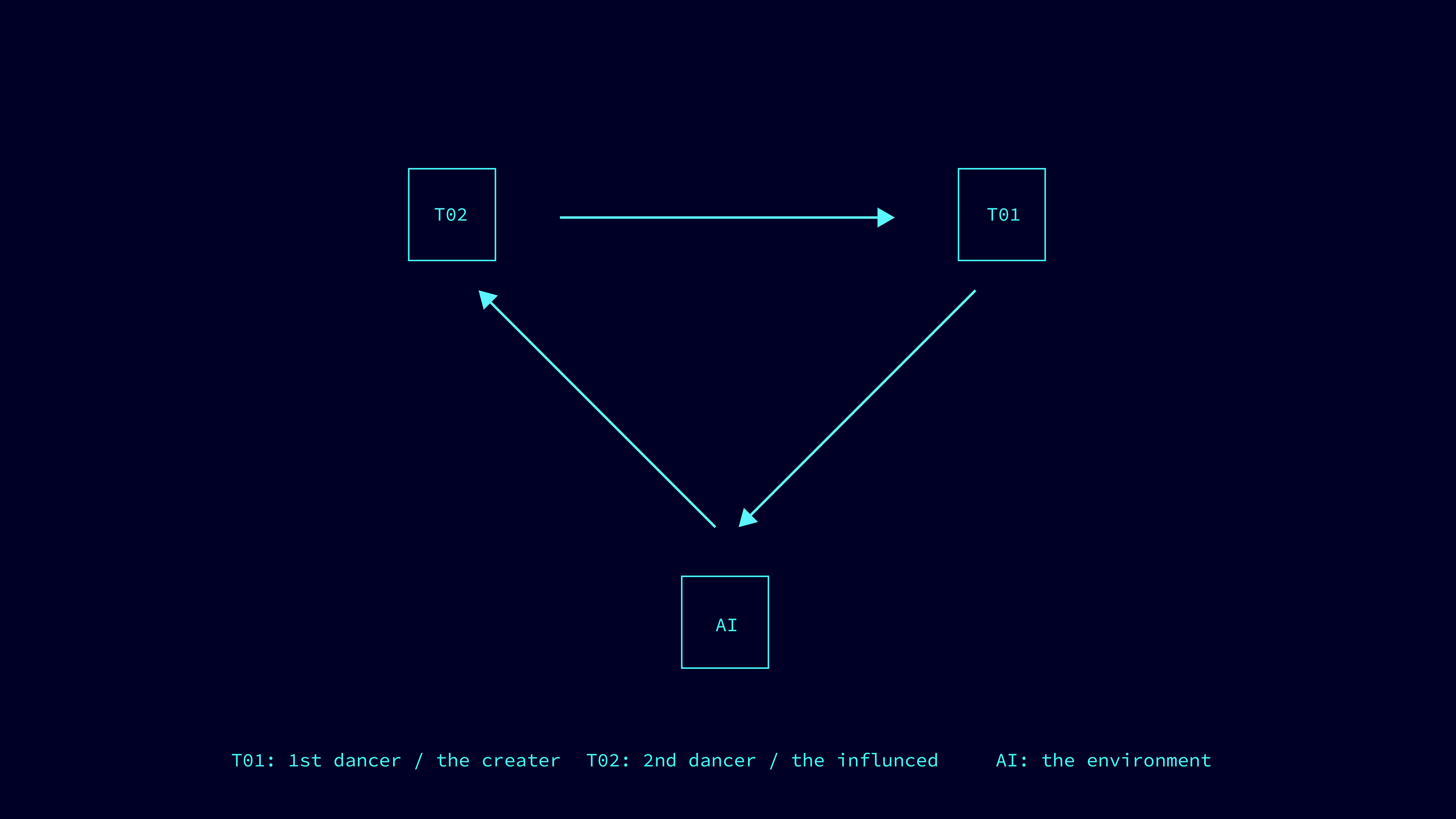The "Blue zone" or “unit m2202” refers to the specific area or "universe" within which the experiment takes place. Nothing outside of this zone is considered or calculated in the experiment, as external noise and movements are blocked by a threshold to ensure that all interactions within this zone are solely between the machine and human entities.

The experiment is designed to track the movement of a human on stage using a Kinect camera as the input device. The camera captures information about the position, rotation, and proportion of the body in physical space and converts it into values between -1 and 1. These values are then sent to the machine's input device as raw data.
Communication and language.
I - Camera, Human Ears, Human Eyes
O- Speaker, human body movement
The interaction between inputs and outputs is a cyclic and exponential interaction. One will have to start the dialogue between these two different entities. Once a signal between the entities is sent, the ritual starts. It is mainly humans who have the will to start the conversation, also the ability to press on the triggers. Machines are also able to do so if programmed.
The machine's processing unit, a personal computer (PC), uses software to read the raw data and map it to trigger MIDI instruments on a digital audio workstation. The processed elements are then sent to an output device, such as a speaker, which sends out audio signals to the human who is listening through their ears.
The human's ears receive the audio signals, which are then processed by the brain to trigger kinetic movements, sending messages to the body parts of human 1 and human 2. This movement re-triggers the input device of human 1 and starts the cycle again.
To make the experiment work, humans must study a cognitive mapping table that sets a lexicon, defining the relationship between movement and sound. The audio signal has different elements such as notes, launch, velocity, frequency, resonance, note length, waveform shape, panning, and volume.
The translation of movement to sound is based on sets of "if conditions" processed in the human brain. For example, if the left hand z-position of human 1 is at 0.5 and the x-position is in the range of 0.1 to 0.4 of human 1, a sound will trigger. If the conditions are not met, nothing happens. The values from the human's body movement are used to decide on the pitch, velocity, frequency, and other elements that will be sent back to human 2.
It's important to note that the machine is considered as one entity that has three parts: Input, processor, and Output. Similarly, human 1 and human 2 are considered as one entity that has three parts Input, processor, and Output.
When human 1 sends a message with high values, this can result in a high-value response at the other side, potentially leading to an oversaturated result. This oversaturated result can translate into an exponential oversaturated result, until both entities are in a disturbing area where the frequency is too high and the loudness is unbearable, and human 2 won’t be able to move or reach the specified values.
It's important to note that there are rules and thresholds that should not be crossed, as crossing the limit will destroy the cycle. Movement is restricted within certain boundaries.
Human x2 is intentionally defined as such because both humans' actions are not counted as individual actions of two separate people, but a sum of both their actions are seen as one, the acts of humanity. They are considered one entity that has communication with another entity, an external one.
In this experiment, there is no direct communication between human 1 and human 2. Both individuals follow the same set of rules outlined in the cognitive mapping table. Their responsibility is to accurately translate and resend the signals received, ensuring that the meaning and intent of the original signal is upheld. Any action or inaction taken by either human 1 or human 2 can affect the outcome of the experiment. If either individual overreacts, it may result in high values being sent, which could make it difficult for the other individual to reach the specified movement values. The goal of this communication is to ensure that neither individual is harmed in the process. The limits of how far humans can push in this experiment are determined by the predetermined thresholds and boundaries set in the blue zone.
How far can we push?
Concept Akad Heider & OMAR TARA
code design Omar TarA
Performance Akad Heider & Mo Al-Ali
documentation Ala Hamameh & Hazem Obeid
Softwares touchdesigner & Ableton
